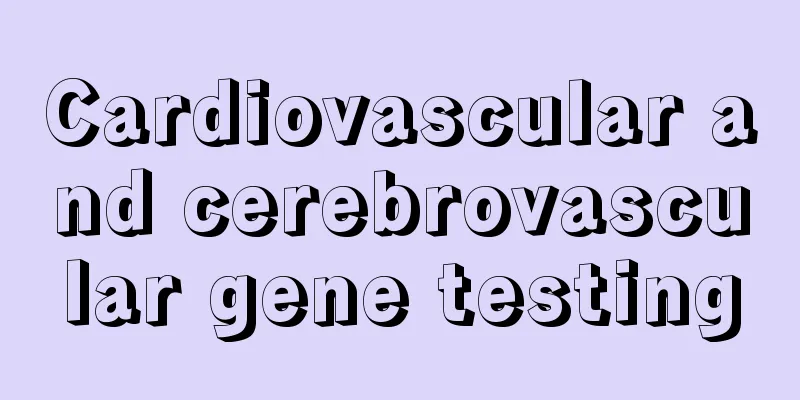Cardiovascular and cerebrovascular gene testing

|
Cardiovascular and cerebrovascular disease is a very common problem among the elderly. It mainly affects the blood supply function of the blood vessels between the heart and the brain. Cardiovascular and cerebrovascular diseases can cause diseases such as cerebral infarction and blood vessel blockage. Moreover, modern medical technology research has found that cardiovascular and cerebrovascular diseases are caused by certain genetic problems. Therefore, we can now predict and prevent the probability of cardiovascular and cerebrovascular diseases based on the genes in the human body. So how are cardiovascular and cerebrovascular diseases detected? Cerebral infarction (cardiovascular and cerebrovascular): Current status of cerebral infarction Cerebral infarction, also known as ischemic stroke, refers to ischemic necrosis or softening of localized brain tissue caused by impaired blood supply to the brain, ischemia and hypoxia. As a sudden brain disease, it can occur at any age, and the degree of necrosis varies depending on the location and size of the thrombus. It is more common in middle-aged and elderly people aged 45 to 70. The causes of cerebral infarction are complex and are the result of the combined effects of genetic and environmental factors. Research on genetic polymorphisms of cerebral infarction involves multiple genes such as MTHFR, ALOX5AP, APOE, TNFSF4, and CYP11B2 genotyping. Among them, at the important site rs7412 on the APOE gene, the change of the base C→T causes the change of Arg→Cys at the 176th position of the protein peptide chain it encodes. Studies have shown that the polymorphism of this site is closely related to the susceptibility of Alzheimer's disease and cerebral infarction in the population. Symptoms of cerebral infarction Common symptoms: ① Subjective symptoms: headache, dizziness, vertigo, nausea and vomiting, motor and (or) sensory aphasia, and even coma. ② Cranial nerve symptoms: both eyes staring toward the side of the lesion, central facial paralysis and tongue paralysis, pseudobulbar palsy such as choking when drinking water and difficulty swallowing. ③ Physical symptoms: hemiplegia or mild hemiplegia, hemisesthesia, unstable gait, limb weakness, incontinence, etc. If the genetic susceptibility genetic testing system assessment conclusion indicates that your risk of cerebral infarction is higher than that of the general population. We recommend that you: ① Eat more whole grains and fresh fruits and vegetables, especially black fungus, black beans, black rice, etc. ②Quit smoking and limit alcohol consumption. Excessive smoking and drinking can cause cerebral infarction. ③ Develop good living habits and ensure adequate sleep and rest time. Stick to having bowel movements between 5 and 7 in the morning and relax and rest between 7 and 9 in the evening. ④Pay attention to psychological balance. Listen to more music, go out for walks often, and maintain an optimistic mood. ⑤ For diseases such as hypertension, heart disease, diabetes, arteriosclerosis, etc., once discovered, they should be taken seriously and regular observation and treatment should be carried out under the guidance of a doctor. ⑥Keep exercising. Stick to walking exercises with an effective step count of 6,000 steps every day, and do aerobic exercise for more than 30 minutes 3-5 times a week, such as jogging, cycling, swimming, etc. Lack of exercise can cause slow blood flow and increased blood lipids. It is cold in winter, and the cold stimulation can easily cause blood vessels to contract strongly, which can easily cause cardiovascular and cerebrovascular diseases. You should wait until the sun rises before exercising. At this time, the temperature rises, which can prevent the body from being suddenly stimulated by cold and becoming ill. It is recommended that you undergo regular health checks. Additional cerebral infarction-related examinations may include: blood lipids, blood sugar, blood viscosity, carotid artery ultrasound, and brain CT. If you experience any related symptoms, please go to the hospital's neurology department for examination. Stroke (cardiovascular and cerebrovascular): Current status of stroke Stroke, also known as cerebral infarction, is characterized by high morbidity, high disability rate, high mortality rate, high recurrence rate and many complications. Its annual incidence rate is 140/100,000 to 200/100,000 people on average worldwide, and is higher in Orientals than in Westerners. There are two major categories of risk factors for stroke. One category is unchangeable factors such as genetics, age, and race. The other category of risk factors that can be changed through intervention mainly includes: high blood pressure, heart disease, diabetes, smoking, alcoholism, hyperlipidemia, etc. Research on stroke gene polymorphism involves multiple genes such as MTHFR, ABCA1, and AGT genotyping. Among them, people carrying the C677T polymorphism of the MTHFR gene are more likely to suffer a stroke than ordinary people at the genetic level. For people with MTHFR gene abnormalities, the metabolic pathway of folic acid they consume is blocked in the body, which may cause hyperhomocysteinemia, interfere with the anticoagulant function of endothelial cells, and lead to an increased tendency to coagulation. Hyperhomocysteinemia is an independent risk factor for atherosclerosis and stroke (including ischemic stroke and hemorrhagic stroke). Stroke symptoms Main warning signs: ① Dizziness, especially sudden onset of vertigo; ② Headache, headache that is different from usual headache, that is, headache that suddenly gets worse or changes from intermittent headache to continuous severe headache; ③ Limb numbness, sudden numbness on one side of the face or hands and feet, some may experience numbness in the tongue, lips, or one side of the upper and lower limbs; ④Sudden weakness or inflexibility of one limb, which occurs intermittently; ⑤ Temporary slurred speech or difficulty in speaking; ⑥Sudden unexplained falls or fainting; ⑦ Mental changes, temporary loss of consciousness, sudden changes in personality and temporary impairment of judgment or intelligence; ⑧Drowsiness occurs, that is, feeling drowsy all day long; ⑨Sudden blurry vision or a black blur in front of the eyes, or even temporary blindness; ⑩Nausea, vomiting or hiccups, or blood pressure fluctuations accompanied by dizziness, blurred vision, and tinnitus; ⑪ Involuntary twitching of one side or one limb; ⑫ Nosebleeds, especially frequent nosebleeds. If the genetic susceptibility testing system assessment conclusion suggests that your risk of stroke is higher than the general population. We recommend that you: ① Eat some marine fish products in moderation. Marine fish products can improve vascular elasticity and promote sodium excretion (except for those with chronic renal insufficiency). The unsaturated fatty acids in them can also prevent cardiovascular and cerebrovascular diseases. ② Consume some plant protein in moderation, such as soy products (except for gout patients). ③Keep warm. In winter, people should avoid sudden changes from higher indoor temperatures to lower outdoor temperatures (especially the elderly). ④ Patients with a history of stroke should be more careful to prevent falls; they should be slow in daily movements such as getting up and bending down to tie shoelaces, and bathing time should not be too long. ⑤Keep exercising. Stick to walking exercises with an effective step count of 6,000 steps every day, and do aerobic exercise for more than 30 minutes 3-5 times a week, such as jogging, cycling, swimming, etc. Control your weight. You need to do warm-up exercises before exercising. The intensity of exercise should be enough to make you sweat a little and your breathing slightly faster but not affect your conversation. When exercising, you should proceed step by step, and avoid movements that require you to hold your breath, rotate quickly, exert too much force, or lower your head too deeply. It is recommended that you undergo regular health checks. Additional stroke-related tests may include: blood lipids, blood sugar, blood viscosity, and carotid artery ultrasound. If you experience related symptoms, please go to the hospital's neurosurgery department (for severe cases) or neurology department (for mild cases) for examination. Atherosclerosis (cardiovascular and cerebrovascular): Current status of atherosclerosis Atherosclerosis is the most common and most harmful disease. It is a type of arteriosclerosis. Yellow substances containing cholesterol and fat appear in the intima of large and medium arteries. It is mostly caused by fat metabolism disorders and neurovascular dysfunction. It often leads to thrombosis, blood supply disorders, etc. Atherosclerosis is more common in men over 40 years old and women after menopause. This disease is often accompanied by hypertension, hypercholesterolemia or diabetes. It is more common among people who do mental work, and is a serious threat to people's health. It is one of the main causes of death among the elderly. Research on atherosclerosis gene polymorphism involves multiple genes such as MTHFR, PON1, CDKN2A, APOB, ALOX5AP, TNFSF4, and CETP genotyping. Among them, at the important site rs693 on the APOB gene, the conversion of the base C→T does not change the type of protein it encodes, but it has a certain effect on the stability of the protein structure or the shearing of messenger RNA. The polymorphism of this locus is closely related to cholelithiasis and atherosclerosis. Symptoms of Atherosclerosis Early symptoms: ① Feeling uncomfortable in the head. The patient often feels that the hair is heavy and stuffy (the head feels tight and oppressive), dizziness and headache, often accompanied by tinnitus and blurred vision. ②Poor sleep. The most common symptoms are difficulty falling asleep, easy awakening, difficulty falling asleep again after waking up, and frequent and clear dreams. Sometimes, there may be excessive sleep, drowsiness, mental fatigue, or alternation with insomnia, with no regular pattern. ③ Recent memory loss. Tends to forget names, numbers, and recent events. Usually, their concentration is scattered, their movements become slow, and their reactions are not sensitive, so they interact less with others, like to be alone, have a more withdrawn temperament, and are difficult to get close to. ④ Decreased comprehensive judgment ability. The ability to comprehend new things declines, work efficiency decreases, and one feels incompetent for the job. As the disease worsens, the patient will gradually become indifferent, lack interest in surrounding things, and lack enthusiasm towards people. ⑤Abnormal emotions. They often get excited, lose their temper, feel sad, and have mood swings over trivial matters in life. Their abnormal personality manifests itself in enthusiasm turning into indifference, and generosity turning into stinginess. Some patients may also experience emotional disorders such as anxiety, depression or fear. ⑥Temporary numbness of the limbs. Numbness, weakness, or abnormal sensation in one limb or part of a limb. ⑦Unsteady gait. Patients may experience unsteady walking and turning, with slow gait or unsteady walking, and may be prone to falling. If the genetic susceptibility testing system assessment conclusion suggests that your risk of atherosclerosis is higher than the general population. We recommend that you: ① Eat more black fungus, black beans, and black rice; pay attention to supplementing vitamin C and trace elements. Foods rich in vitamin C include sour jujube, fresh jujube, sea buckthorn, red pepper, kiwi, bitter melon, cabbage, beans, potatoes, and chrysanthemum. ② Balance meat and vegetables. Eating only vegetarian food for a long time will cause the blood vessel walls to be too thin and fragile. ③Consume more iodine (except for patients with hyperthyroidism). Iodine can effectively reduce the deposition of cholesterol in the arteries and prevent the occurrence of arteriosclerosis. Kelp, seaweed, dried shrimp, jellyfish skin, etc. are rich in iodine. ④ Take appropriate amount of supplements. Eat less pork, beef and mutton, but you can eat some poultry; in winter, you should take supplements in moderation. A large amount of hot food and nourishing medicinal wine can easily cause increased blood lipids and induce cardiovascular and cerebrovascular diseases; limit cholesterol intake. Foods rich in cholesterol include egg yolks and various animal brains. Eat no more than one egg a day. ④Quit smoking. Smoking can inhibit the activity of lipoprotein lipase, increase triglycerides, decrease high-density lipoprotein cholesterol, destroy the function of endothelial cells, and cause symptoms such as arterial spasm. It is very harmful to patients with dyslipidemia and atherosclerosis, and they must quit smoking. ⑤Keep exercising. Stick to walking exercises with an effective step count of 6,000 steps every day, and do aerobic exercise for more than 30 minutes 3-5 times a week, such as jogging, cycling, swimming, etc. Lack of exercise can cause slow blood flow and increased blood lipids. It is cold in winter, and the cold stimulation can easily cause blood vessels to contract strongly, which can easily cause cardiovascular and cerebrovascular diseases. You should wait until the sun rises before exercising. At this time, the temperature rises, which can prevent the body from being suddenly stimulated by cold and becoming ill. It is recommended that you have regular health checks. Additional atherosclerosis-related tests include: blood lipids, blood sugar, blood viscosity, carotid artery color ultrasound, cardiac color ultrasound, transcranial Doppler, and homocysteine (Hcy). If you experience any related symptoms, please go to the hospital's cardiology department for examination. Deep vein thrombosis (cardiovascular and cerebrovascular): Deep vein thrombosis status Deep vein thrombosis refers to the abnormal coagulation of blood in the deep veins and is a disease of venous reflux disorder in the lower limbs. Thrombosis usually occurs during immobilization (especially major orthopedic surgery). The three main pathogenic factors are slow blood flow, venous wall damage and hypercoagulable state. In recent years, the number of patients with deep vein thrombosis has increased year by year. Many patients lack typical clinical manifestations and objective evidence, and only 10% to 17% of patients with deep vein thrombosis have obvious symptoms. The most serious clinical feature and sign of deep vein thrombosis is pulmonary embolism, which is more common in patients with deep vein thrombosis in the lower limbs. The mortality rate is as high as 9% to 50%, and the vast majority of deaths occur within a few minutes to a few hours. Death from upper extremity vein thrombosis is very rare. Deep vein thrombosis with symptoms and signs is more common in patients after surgery, trauma, advanced cancer, coma and long-term bedridden patients. Research on deep vein thrombosis gene polymorphism involves multiple genes such as MTHFR, FGG, JAK2, F11, and CYP4V2 genotyping. Clinical observations have also found that children whose parents have a history of deep vein thrombosis have a higher risk of developing the disease. Therefore, children of patients with lower limb deep vein thrombosis should be more vigilant about its occurrence. Deep vein thrombosis symptoms Clinical manifestations: The causes and locations of deep vein thrombosis vary, and the clinical manifestations are also different. There are three main clinical symptoms: swelling, cyanosis, and pain caused by thrombosis. ① Early stage: It often manifests as sudden swelling of one limb, first in the calf and then in the thigh. ② During the aggravation period, the pain in the affected limb worsens and lameness may occur. ③ Late stage: Toenails become deformed and thickened, and unusual sensations occur in the limbs, such as burning, tingling, and numbness. The patient has a strong systemic reaction, and some patients even have high fever, tissue necrosis, and ulcers. If the genetic susceptibility testing system assessment conclusion indicates that your risk of deep vein thrombosis is higher than the general population. We recommend that you: ① Eat more whole grains and fresh fruits and vegetables, especially black fungus, black beans, black rice, etc. ② Limit the intake of animal fat. When cooking, you should use more vegetable oils (such as peanut oil, soybean oil, and rapeseed oil). ③ Eat less broth, because broth contains more nitrogen extracts, which will lead to an increase of uric acid in the body and increase the burden on the heart, liver, and kidneys. ④ Wear comfortable clothes and avoid tight clothes. Elastic stockings should be worn under the guidance of a doctor. ⑤ Develop good living habits and ensure adequate sleep and rest time. Stick to having bowel movements between 5 and 7 in the morning and relax and rest between 7 and 9 in the evening. ⑥Keep exercising. Stick to walking exercises with an effective step count of 6,000 steps every day, and do aerobic exercise for more than 30 minutes 3-5 times a week, such as jogging, cycling, swimming, etc. Lack of exercise can cause slow blood flow and increased blood lipids. It is cold in winter, and the cold stimulation can easily cause blood vessels to contract strongly, which can easily cause cardiovascular and cerebrovascular diseases. You should wait until the sun rises before exercising. At this time, the temperature rises, which can prevent the body from being suddenly stimulated by cold and becoming ill. Remember to replenish water after exercise to prevent blood viscosity. It is recommended that you undergo regular health examinations. Additional deep vein thrombosis-related examinations may include: lower limb artery ultrasound, blood lipids, blood sugar, blood viscosity, carotid artery ultrasound, and cardiac color Doppler ultrasound. If you experience any related symptoms, please go to the hospital's vascular surgery department for examination. Summarize Genetic testing for cardiovascular disease susceptibility genes can determine the polymorphism of your tested gene, and then understand your genetic factors for these diseases, help you understand the causes of your own cardiovascular disease, and assess your relative risk of developing these diseases. However, when you see high-risk items on your report, you don’t need to be too nervous. You should combine the test report with the expert advice to avoid conditions that may detonate "landmines" through various means such as adjusting the nutritional structure, changing the lifestyle and living habits; and customize personalized health examinations in a targeted manner to prevent the occurrence of diseases. |
<<: What diseases can Bigu cure
>>: Diet for patients with cardiovascular and cerebrovascular diseases
Recommend
What is the reason for the grinning mouth
The weather is dry in winter and people are prone...
Nursing care for giant sacrococcygeal teratoma resection in infants and young children
Experts say that sacrococcygeal teratoma is the m...
The efficacy of orange peel pillow
Nowadays, people's insomnia is becoming more ...
The harm of smoking to the fetus
We know that pregnancy is actually quite painful ...
What are the detection methods for bone cancer
Nowadays, more and more people are suffering from...
Preserved mustard greens sesame cake calories
In many areas in southern my country, pickled mus...
What are the functions of gastrointestinal smooth muscle
The structure of our body's digestive tract s...
Where does bone cancer usually hurt in women
Bone cancer is a relatively rare but serious mali...
Identification of live and dead scallops
When we choose scallops, we will find that the pr...
Can I get pregnant if I have sex 12 days after an abortion?
There are many women who have just had an abortio...
What should patients with advanced lung cancer pay attention to in their diet? Specific dietary guidance and suggestions for advanced lung cancer
Because patients are weak, they are particularly ...
What should I do if I get pregnant again six months after giving birth?
After giving birth, a woman's health will bec...
What are the symptoms of advanced prostate cancer
What are the symptoms of advanced prostate cancer...
What should I do if my white silk clothes turn yellow?
White silk clothes are very beautiful, clean and ...
Sore throat, yellow phlegm and blood streaks
Many people will suffer from rhinitis when the se...









